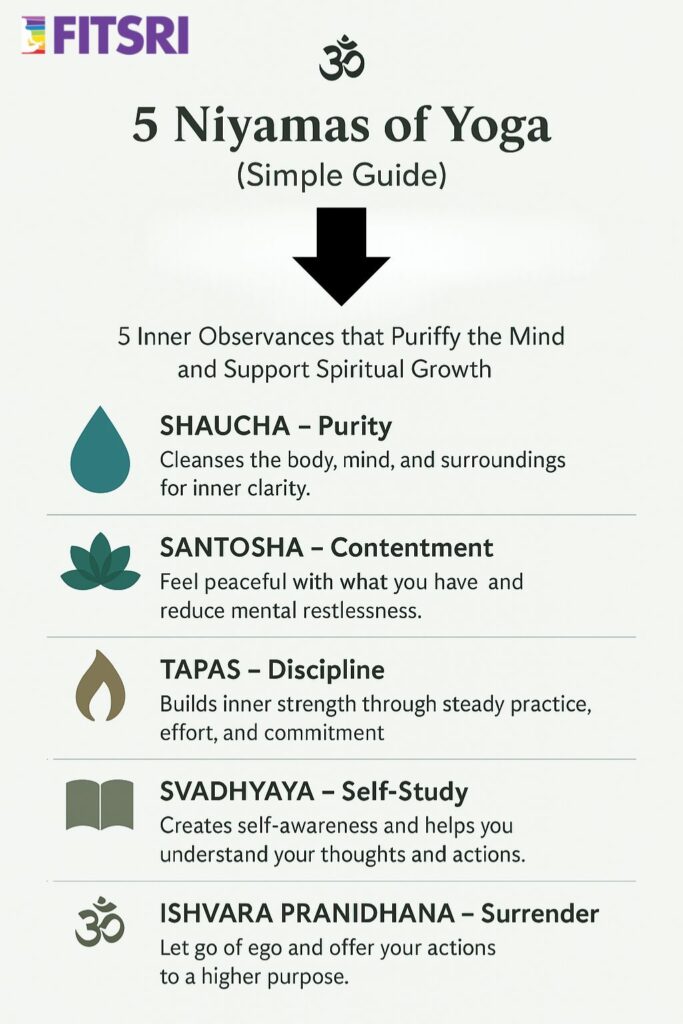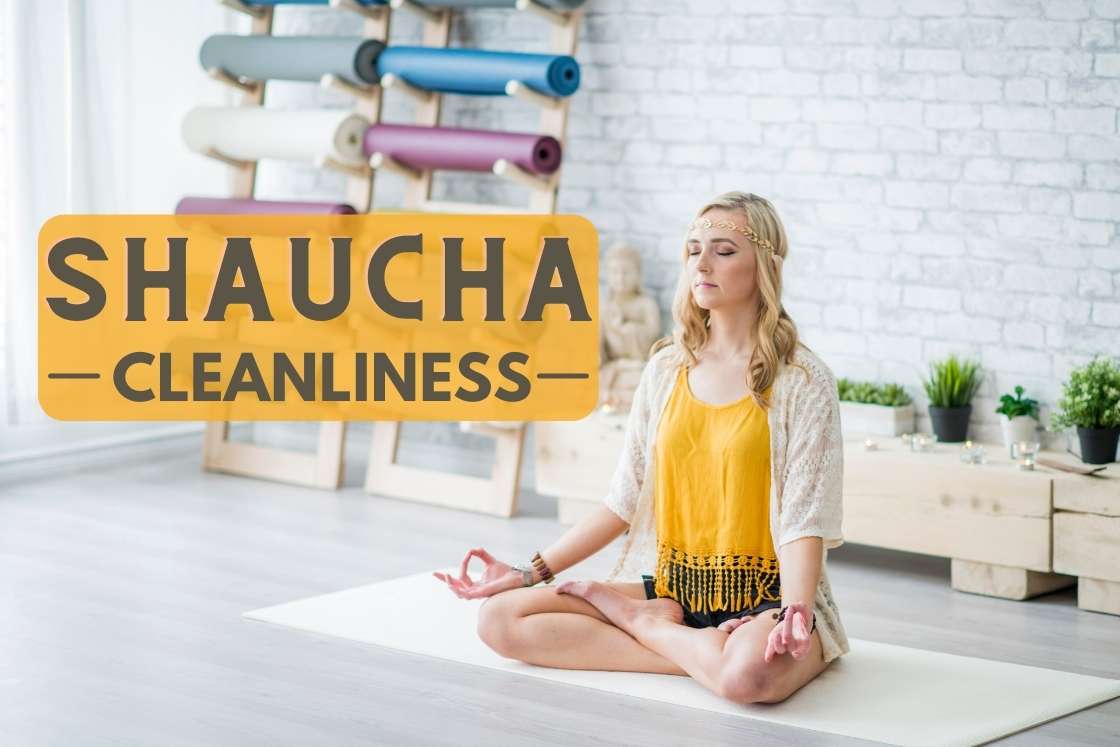
Niyama means “inner observance” in yoga. It is the second limb of Patanjali’s Eightfold Path and teaches personal discipline, self-purification, and mindful living.
Patanjali’s Yoga Sutras describe an eight-step path to reach samadhi, the state where body, mind and soul become one. Niyama is the second limb of this path. It consists of five inner rules that help a practitioner develop discipline, clarity, and purity in daily life.
Niyama is derived from Sanskrit and means “observance” or “positive rule.” While the Yamas guide how we behave with others, the Niyamas teach us how to work with ourselves – our habits, thoughts, and lifestyle.
Patanjali placed Niyama early in the eight limbs because it creates the right mindset for spiritual growth. Practising Niyama builds inner strength, keeping us steady when challenges come on the yogic journey.
Practising Niyama is like preparing the boat and oars before stepping into the deep waters of spiritual practice.
The purpose of Niyama is to cleanse the inner environment – body, mind, and spirit. When this inner balance is achieved, the true nature of the self starts to unfold.
Yama vs Niyama (simple difference)
- Yama: how we act with others (social ethics); mostly “don’ts.”
- Niyama: how we act with ourselves (personal discipline); mostly “dos.”
Yama and Niyama together form the foundation of yoga. Without the first, the second cannot be truly practised.
Also Read: What Are the 5 Yamas in Yoga?
5 Niyamas of Yoga
The 5 Niyamas are personal observances that prepare you for spiritual growth. They help you build discipline, improve inner qualities, and live a balanced life.

- Shaucha – Purity of body and mind
- Santosha – Inner contentment
- Tapas – Discipline that burns impurities
- Svadhyaya – Study of the self
- Ishvar Pranidhan – Surrender to the Divine
Let’s understand each Niyama.
1. Shaucha (Purity)

Saucha means cleanliness or holistic purity of both the body and mind. It is considered one of the most important factors for maintaining health, happiness, and general well-being.
Bodily purity can be achieved through daily ablutions, while inner or mental purity can be cultivated through the conscious practice of Asana (physical postures), Pranayama (breathing exercises), and Dhyana (meditation). Along with daily cleansing of the body, the principle of Saucha also encourages maintaining a clean environment. Saucha includes purity of thoughts as well as speech.
How to purify the mind (simple way)
The mind becomes clear through self-awareness – noticing thoughts, emotions, and reasons behind actions.
This is called Adhyatma Vidya (knowledge of the inner self).
Regular yoga practice makes mindfulness stronger, just like muscles grow when exercised.
Practical ways to purify mind and intellect
Here are simple Shaucha-based habits you can apply daily:
- Eat fresh, pure food: Clean food makes the mind energetic and alert. Very spicy, oily, salty or stale foods disturb clarity.
- Practice daily kindness: Helping others naturally clears ego and opens the heart.
- Speak gently: Calm words bring peace within and harmony with people around you.
- Stay engaged in meaningful work: An idle mind gets restless and negative.
- Keep learning: Study books, wisdom texts, and observe yourself — this links with Swadhyaya.
- Live morally and worship what you believe in: Practising values keeps the heart clean and humble.
Shaucha in Patanjali’s Own Words
Through cleanliness and purity of body and mind comes a purification of the essence, a goodness(energetic) and gladness(peaceful) of feeling, a sense of focus with intentness, the mastery and union of the senses(the self-realized state), and a fitness, preparation and capability for self-realization.”
~ Patanjali, Yoga sutras 2.41
2. Santosha (Contentment)

Santosha means being happy and peaceful with whatever you have. It is the inner joy that remains steady even when life becomes challenging.
When contentment is present, we stop chasing things with a sense of lack. Instead, we act from completeness, balance, and clarity. This shift brings confidence, stability, and deep inner happiness.
Santosha is often ignored, but Patanjali places it at the heart of spiritual growth. Without contentment, it is difficult to experience the peace that meditation promises.
Saucha makes us ready to do things, Santosh is an art of figuring out what we have and what we actually want to achieve.
Practice of Santosha
The moment we realise that we are breathing, and have eyes to see, a nose to smell, skin to feel, tongue to taste, and life to experience, we naturally feel peaceful and contented. However, there is always room for improvement.
Human beings can truly feel satisfied only when the basic elements of life are fulfilled. Maslow’s hierarchy of needs explains the essential elements that must be met for a person to feel genuinely happy and peaceful.
Here is the mountain we need to climb:

When we observe people’s continuous efforts in their day-to-day lives and reflect on the purpose behind these efforts, we realise that everything is driven by the desire for satisfaction and peace. We try to derive contentment from external objects, and this is not wrong as long as nobody is harmed by our actions and our desire to obtain things is not influenced by greed or jealousy. The desire to get something should arise from genuine need, not from greed.
Patanjali says in Sutra 2.42 about Santosha (Contentment):
One who constantly practises contentment weakens the excessive thirst for more, and the sattva (purity) increases. Such a person experiences great happiness and enjoys heavenly pleasures.
The interesting part is that we run all day to get the things we want, but we do not do so with a peaceful, clear mind. The state in which we are conscious, clear, and deeply satisfied while performing actions is called self-realisation.
How to achieve contentment
Contentment can only be achieved when there is less disturbance and more clarity in thoughts. A calm mind is the ultimate goal of yoga, which is why eliminating mental modifications (vrittis) is yoga.
A focused mind can be developed through continuous and conscious practice of physical postures, breathing techniques, and meditation.
Yoga practice does not end within an hour on the mat; it must be practised beyond the mat. The way you sit, work, type, walk — when every action is done with full awareness — that is yoga.
Nothing comes easy, not even contentment. It must be acquired through constant practice. That is why Tapas (Perseverance) is the next Niyama.
3. Tapas (Austerity / Perseverance)

Tapas means bearing discomfort or hardship with the intention of personal growth. Even if there is physical or mental difficulty, one continues the practice with awareness and determination. This is called Tapas.
When learning yogic philosophy, performing asanas, or doing your daily work, some discomfort may arise. One should remain conscious of it and view those hardships from a positive perspective. This is the true practice of Tapas.
Tapas is also known as perseverance, and perseverance is one of the essential keys to success.
Every important task goes through many challenges before achieving results. Those who practise perseverance eventually see progress – sooner or later.
It is important to understand that Tapas does not mean being overly serious or rigid. Rather, it is the inner fire that gets the heart pumping, awakens hope, and strengthens the desire for personal growth..
4. Svadhyaya (Self-Study & Inner Awareness)

Svadhyaya means self-inquiry, and it is one of the most powerful ways to become self-realised.
It involves being aware of what the mind is thinking, what the body is feeling, and what emotions are rising at any moment.
Most people are unaware of how their body reacts after eating certain foods. When a person observes how they feel after a particular meal, they can change their habits if the food does not make them feel good. This awareness of what is happening in the body and mind is the beginning of transformation. When a person becomes aware of their thoughts and actions, introspection naturally follows, and self-knowledge grows.
Western thinkers explored and understood the external world, which led to the creation of inventions like light bulbs, cars, computers, and machines. Indian sages – the rishis and yogis – explored the inner world of thoughts, feelings, and consciousness, and this is why they were able to attain self-realisation.
Sage Patanjali himself used Swadhyaya to understand vrittis (mental fluctuations), kleshas (afflictions), and the ultimate state of peace.
The word “spirituality” literally means “inner.” In Sanskrit, the word adhyatmik refers to awareness of one’s body and mind. Practising yoga asanas makes us aware of the body, pranayama builds awareness of the breath, and meditation deepens awareness of thoughts.
In essence, Swadhyaya is about how well you know yourself. As Lao Tzu beautifully said:
One who knows others is wise and one who knows himself is self-realized.
5. Ishvara Pranidhan (Devotion)

The last Niyama, Ishvara Pranidhana, is the practice of surrendering or dedicating the results of your actions to a higher Self or higher purpose. This attitude prevents the ego of “I” from entering into your actions, and your work naturally becomes part of karma yoga.
Patanjali describes Ishwara as “Purusha Vishesha,” a special kind of pure consciousness — one who never was embodied, is not embodied, and will never be embodied.
The core teaching of yoga revolves around the reality that all consciousness has one source. Through the practice of Ishwara Pranidhana, we realise this truth as we allow our awareness to move from thought to thought with mindfulness.
This Niyama also becomes a powerful solution to human suffering.
Maharshi Patanjali considered OM (AUM) as the remedy for all suffering. Many sages experienced supreme strength and peace simply by chanting the syllable AUM.
Chanting AUM is one of the easiest ways to focus the mind and keep the body relaxed. You can chant it while driving, sitting, travelling, walking or working. Try it yourself and experience how it calms the mind.
Conclusion
The 5 Niyamas guide the inner discipline of a yoga practitioner and help purify the mind and body. Saucha brings cleanliness and clarity, Santosha develops inner contentment, Tapas strengthens perseverance, Swadhyaya builds self-awareness, and Ishwara Pranidhana teaches surrender. Together, these observances form the foundation of yoga, preparing the practitioner for peace, focus, and spiritual growth.




